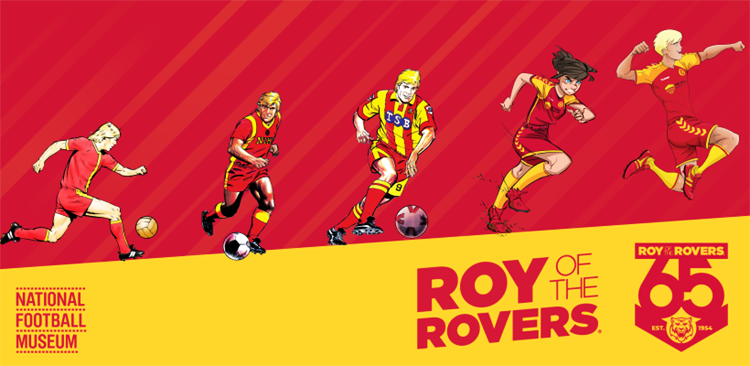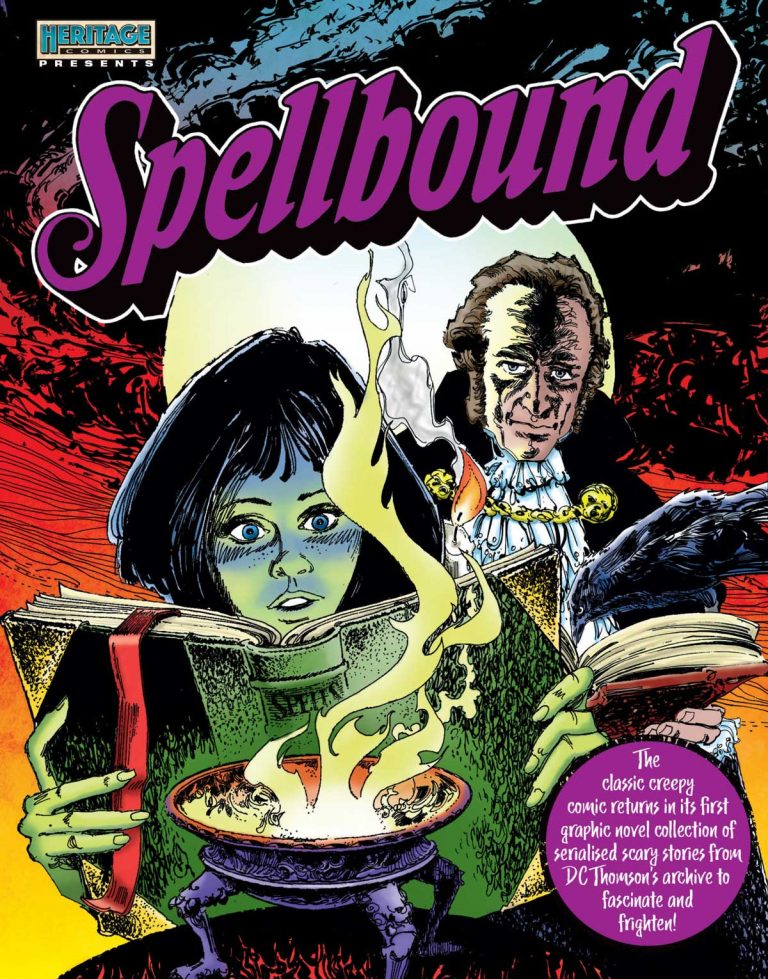This article was last updated on 29th February 2024
If you’re a user of social media you’ll be aware that some British comic fans regularly regale the lack of reprints of classic comic strips, a clamour that has grown since Rebellion acquired the rights to many characters and strips in two stages, from Egmont in 2016 and TI Media in 2018.
Why, some asks, are they still waiting, for example, for collections from Cheeky comic? Where is the collected Adam Eterno from Thunder and Lion? (Right here, as of 2021, actually). Why isn’t there a collection of “The Guinea Pig” from EAGLE, with its beautiful art by Brian Lewis, Colin Andrew and, in the main, Gerry Haylock?
Bear with me. I’m going to try and answer those questions based on my experience as a publisher and, in part, with a little bit of supposition of the assumed working practices of some of the companies who own classic British comic brands today.
Nostalgia is a boom business – and that isn’t going to change anytime soon, I imagine, particularly as we head ever deeper into an unknown and uncertain future courtesy of the Coronavirus Pandemic. Calls for reprints of material from happier times will, I imagine, grow, ironically in marked contrast to the periods when the traditional British weekly was more dominant in newsagents.
Back then both myself and others such as DC Thomson former editor Calum Laird recall one the most common complaint we had when an editor was, “Why do you reprint stories? Let’s have new stories.” Or words to that effect. For myself, when we reprinted strips or materials in Specials at Marvel UK, regular readers complained about felling short changed.
Fans regularly lambast publishers for a lack of reprinted material; but when you’re a publisher such as DC Thomson or Rebellion, how do you choose what to reprint? Different folks want different things, but is what one fan wants a commercially viable prospect over another?
Reprint Factors Number One: Sales
Initially, any publisher launching a reprint program is going to base the collections on a mixture of known sales data and a few “flyers” to test the market. Sales of published collections will then, of course, have the largest influence shaping decisions made on the selection of material for future releases. However, it won’t necessarily mean the less successful titles won’t be reconsidered, just released differently – but I’ll return to that later.
A company with a large portfolio of characters and brands will also assess whether a character or strip they now own might enjoy stronger success in a revamped, updated form, which will also involve some experimentation, through projects such as the expanded Specials line Rebellion are putting out this year that so far has seen release of the Action 2020 Special, which I enjoyed far more, I know, than some diehard original Action fans, particularly “Kids Rule OK” by Ram V and “Hellman of Hammer Force” by Garth Ennis and Mike Dorey.
 One way to generate new interest in old characters and brands – a 21st Century revamp, like the Action 2020 Special
One way to generate new interest in old characters and brands – a 21st Century revamp, like the Action 2020 SpecialRevamps can work, and may boots interest in reprints of the original strips, and I applaud the effort put into them by all involved, although of course I must admit to a little bias here, having written Buster revival strips for both of the Cor! and Buster Specials, the next one due for release next week.
But to support my claims, I point you toward the fact that even Rebellion were blown away by the success and press interest in their brilliant revival and new take on Roy of the Rovers, which has also spurred reprints of classic strips.
 The revamp of Roy of the Rovers has been a tremendous success for Rebellion
The revamp of Roy of the Rovers has been a tremendous success for RebellionSadly, it does appear that getting traction with other revamps is proving more of a slow burn, with little media interest in the excellent range of girls comics collections from titles such as Misty and Jinty. Despite the quality of the strips reprinted, in terms of both script and art, collections such as Bella at the Bar or the beautiful The Jordi Badia Romero Collection don’t seem to have captured hearts and minds in the same way as Melchester Rovers finest.
Perhaps this also explains DC Thomson‘s reticence to relaunch Spellbound, which was ramping up for a digital relaunch, initially as a collection, and then almost as suddenly withdrawn with no explanation to those of us who bought a copy before the shutters unexpectedly closed and no access to their digital purchase. However, sources suggest there was also some sort of internal division within the Dundee-based company that caused the project’s cancellation and ensuing deletion of related social media accounts. Let’s hope it sees the light of day at some point.

Still not released – a revamped Spellbound from DC Thomson
The revamp of, largely, weekly boys comics traditional heroes has similarly fallen foul of less than stellar response to the determined and welcome efforts of Simon Furman, Simon Coleby, editor Keith Richardson and many others to create a coherent and entertaining “Rebellion-verse” through the pages of The Vigilant, which is being released as a collection in September. Speaking personally, my feeling is that this project was largely derailed, despite the work put into trailing in it in the Scream and Misty Specials, by the frequency of release, which has resulted in the decision to round off the saga in Judge Dredd Megazine.
(For those complaining about that, however, I’d suggest they be thankful we at least get an ending – and that this decision may well benefit sales of the Megazine, which is no bad outcome).
Reprint Factors Number Two: Production Costs
Another factor in deciding what to reprint are the production costs of creating a collection, which will probably be calculated after the sales of past collections have been assessed. These include sourcing good copies of the original comic (because not much artwork has survived), sourcing good, high quality scans at 300DPI or more (and no, buying illegal pirated CDs of material from dodgy sellers on eBay is not a solution, because quite apart from anything else, the scans are too low resolution), cleaning those scans, colour balancing, commissioning surrounding editorial material, paying staff to do the work, not to mention marketing costs in a world where building brand in competition with other media is tough and you only have a small but dedicated and, by fans, under appreciated team to do it with.
Reprint Factors Number Three: Distributor Limits
Regarding the general pace of reprints from any British comics company, fans aren’t generally aware that book distributors, not the publisher, often set limits on the number of books they can reasonably “sell in” to book shops. When collections was part of the package planned for Print Media Productions, the bizarrely-run Bosnian company I worked for that published the short-lived STRIP Magazine, our distributors of choice advised us to publish no more than 12 books at most in one year. So, actually, Rebellion are doing far more than many!
Having their own distribution through their web shop helps, of course, where you can find their exclusive Janus Stark collections.

“Selling in” vintage material to the books trade is also hard no matter how many titles you plan, often beginning some 18 months ahead of actual release. US book distributors, for example, demand initial promotional material some twelve months before publication, even if covers might change.
Reprint Factors: The Good News…
This isn’t the first time I have noted the number of factors that impact on collection decisions. However, as I noted earlier, creating new material inspired by the original raises the profile of the originals, and if your new projects are a commercial success, that can, hopefully, buoy the chances of reprints. So buying the next Cor and Buster Special will, in a round about way, improve the chances of collections of some older fans remember reading the first time around, from the 1950s through to the early 1990s.
But as fans, we should also be realistic in our demands. Collections of the best of British strips are, perhaps, on first printing, going to sell perhaps 2000 – 3000 copies at most, to fans of the original who sadly there are less of, as we all age and the original comics become a more distant memory. It’s not an easy balance, but I know that the team at Rebellion, for example, would dearly love to get as much of their archive out in print through their own imprints – or, for lees commercial propositions, working in partnership with publishers with a proven track record of success reaching a niche audience, such as Hibernia Comics, and the Book Palace Books Publishing team.
I’d personally like to thank Rebellion for publishing the collections they are, offering a great mix of titles, such as the recently-released first volume of The Trigan Empire, even if like other fans there are some characters I’d dearly love to see back in print. But like others, I will just have to be patient, won’t I?
John Freeman
WEB LINKS
• Incoming: 2000AD and Treasury of British Collections and Specials – 2020
• Classic British Comics: Who Owns What?
• Treasury of British Comics Web Shop
• There’s a smashing interview with Keith Richardson, editor of the Rebellion Specials, on the 2000AD web site here
• Book Palace Books Publishing
• The Power Pack of Ken Reid is available here from the Kazoop web shop, or eBay
The founder of downthetubes, which he established in 1998. John works as a comics and magazine editor, writer, and on promotional work for the Lakes International Comic Art Festival. He is currently editor of Star Trek Explorer, published by Titan – his third tour of duty on the title originally titled Star Trek Magazine.
Working in British comics publishing since the 1980s, his credits include editor of titles such as Doctor Who Magazine, Babylon 5 Magazine, and more. He also edited the comics anthology STRIP Magazine and edited several audio comics for ROK Comics. He has also edited several comic collections, including volumes of “Charley’s War” and “Dan Dare”.
He’s the writer of “Pilgrim: Secrets and Lies” for B7 Comics; “Crucible”, a creator-owned project with 2000AD artist Smuzz; and “Death Duty” and “Skow Dogs” with Dave Hailwood.
Categories: British Comics, Creating Comics, downthetubes Comics News, downthetubes News

 The SEQUENT’ULL Interviews: Dan White
The SEQUENT’ULL Interviews: Dan White  Sports comic highlights an immortal rugby match
Sports comic highlights an immortal rugby match  The SEQUENT’ULL Interviews: Michelle Freeman
The SEQUENT’ULL Interviews: Michelle Freeman  The SEQUENT’ULL Interviews: Colossive Press
The SEQUENT’ULL Interviews: Colossive Press
Insightful article, thank you!
Things are never simple. For instance, I e-mailed Rebellion to ask about reprints for COMPUTER WARRIOR and DOOMLORD. Given other Eagle strips have been reprinted, I thought there might be some interest; but I learnt, to my surprise, that the Dan Dare Corporation owns the rights to those strips.
So there is always a reason, but it doesn’t stop some people ranting. Same with TV. Someone on Facebook complained about Disney+ not airing the 1960s FANTASTIC FOUR cartoon, but that was produced by Hanna-Barbera, and I believe WB own the righs to that.
There are many strips I’d love to see reprinted, including the aforementioned COMPUTER WARRIOR, but for rights reasons, and the reasons you describe, it’s never clear-cut. I mean, would COMPUTER WARRIOR be viable in the sense that it used to feature licensed computer games? Would there be any rights hurdles there? Sometimes the most obscure reasons prevent it. Who’d have guessed the Dan Dare Corporation had the rights to DOOMLORD and COMPUTER WARRIOR?
All your reasons are worth thinking about. I mean, I’d love to see some obscure Eagle strips reprinted, but would there be enough people buying them?
Well worth checking my “Classic British Comics – Who Owns What?” page for information on brands and characters!
DoomLord & other Eagle 2 strips have been reprinted by Hibernia. Small print runs but DoomLord may still be available.
Thank you, I shall check it out. Things are never clear-cut, eh?